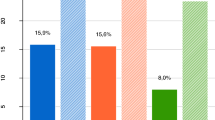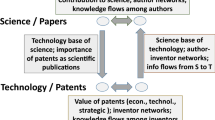Abstract
The paper presents a methodology for studying the interactions between science and technology. Our approach rests mostly on patent citation and co-word analysis. In particular, this study aims to delineate intellectual spaces in thin-film technology in terms of science/technology interaction. The universe of thin-film patents can be viewed as the macro-level and starting point of our analysis. Applying a bottom-up approach, intellectual spaces at the micro-level are defined by tracing prominent concepts in publications, patents, and their citations of scientific literature. In another step, co-word analysis is used to generate meso-level topics and sub-topics. Overlapping structures and specificities that emerge are explored in the light of theoretical understanding of science-technology interactions. In particular, one can distinguish prominent concepts among patent citations that either co-occur in both thin-film publications and patents or reach out to one of the two sides. Future research may address the question to what extent one can interpret directionality into this.
Similar content being viewed by others
References
BEVER, M. B. (1986), Encyclopedia of Material Science and Technology. Pergamon Press Ltd, USA, pp. 4989-4991.
BHATTACHARYA, S., BASU, P. (1998), Mapping a research area at the micro level using co-word analysis. Scientometrics, 43 (3): 359-372.
BHATTACHARYA, S, SUKEEJA, G., BASU, P. (1999), Mapping the knowledge domain of a research field through scientometric indicators. In: MACIAS-CHAPULA. C. A. (Ed.), Proceedings of the Seventh Conference of the International Society for Scientometrics and Informetrics. Universidad de Colima, Colima, pp. 37-50.
BHATTACHARYA, S., KHAN, M. T. R. (2001), Monitoring technology trends through patent analysis. Research Evaluation, 10 (1): 33-45.
CALLON, M., COURTIAL, J. P., TURNER, W. A., BAUIN, S. (1983), From translations to problematic networks: An introduction to co-word analysis. Social Science Information, 22: 191-235.
CAMPBELL, R. S., NEIVES N. L. (1979), Technology Indicators Based on Patent Data: The Case of Catalytic Convertors. Phase I Report, Design and Demonstration. Batelle Pacific Northwest Laboratories, n.p.
CASIMIR, H. B. J. (1971), Industries and academic freedom. Research Policy, 1: 3-8.
COLLINS, P., WYATT, S. (1988), Citations in patents to the basic research literature. Research Policy, 17: 65-74.
DAVID, C. M., ROSENBERG, N. (1982), The influence of market demand upon innovation: a critical review of some empirical studies. In: ROSENBERG, N. (Ed.), Inside the Black Box: Technology and Economics. Cambridge University Press, Cambridge, pp. 193-241.
FAGERBERG, J. (1987), A technology gap approach to why growth rates differ. Research Policy, 16: 87-99.
GRUPP, H., SCHMOCH, U. (1992) Perceptions of scientification of innovation as measured by referencing between patents and papers: dynamics in science-based fields of technology. In: GRUPP, H. (Ed.), Dynamics of Science based Innovation. Springer-Verlag, Germany, pp. 73-122.
GIBBONS, M., LIMOGES, C., NOWOTNY, H., SCHWARTZMAN, S., SCOTT, P., TROW, M. (1994), The New Production of Knowledge: The Dynamics of Science and Research in Contemporary Societies. Sage publications, London.
GLUCER, D. A., SHAH, S. I. (Eds) (1995), Handbook of Thin Film Process Technology: User Guide. Institute of Physics, London.
GRUPP, H., SCHMOCH, U. (1992), Perceptions of scientification of innovation as measured by referencing between patents and papers: dynamics in science-based fields of technology. In: GRUPP, H. (Ed.), Dynamics of Science based Innovation. Springer-Verlag, Germany, pp. 73-122.
GUPTA, V. K., PANGANNAYA, N. B. (2000), Carbon nanotubes: bibliometric analysis of patents. World Patent Information, 22: 185-189.
IRVINE, J. et al. (Ed.) (1997), Equipping Science for the 21st century. Edwer Elger Publishing Ltd., Lyme: US.
MARTIN, B., SALTER, A. (1996), The Relationship between Publicly Funded Basic Research and Economic Performance. Brigton: SPRU, University of Sussex.
MEYER, M. (2000a), Does science push technology? Patents citing scientific literature. Research Policy, 29: 409-434.
MEYER, M. (2000b), What is special about patent citations? Differences between scientific and patent citations. Scientometrics, 47 (2): 93-124.
MEYER, M. (2001), Patent citation analysis in a novel field of technology: an exploration of nano-science and nano-technology. Scientometrics, 51 (1): 163-183.
MOWERY, C. D., ROSENBERG, N. (1982), The influence of market demand upon innovation: a critical review of some empirical studies. In: ROSENBERG, N. (Ed.), Inside the Black Box: Technology and Economics. Cambridge University Press, Cambridge, pp.193-241.
NARIN, F. (1994), Patent bibliometrics. Scientometrics, 30 (1): 147-155.
NARIN, F., NOMA, R. (1985), Is technology becoming science?. Scientometrics, 7: 369-381.
NARIN, F., OLIVASTRO, D. (1992), Status report-Linkage between technology and science. Research Policy, 21 (3): 237-249.
NARIN F., OLIVASTRO, D. (1988), Patent citation analysis: New validation studies and linkage statistics. In: A. F. J. Van RAAN, A. J. NEDeRHOFF, H. F. MOED (Eds), Science Indicators: Their Use in Science Policy and Their Role in Science Studies, DSWO Press, Leiden, pp. 14-16.
NIGHTINGALe, P. (1998), A cognitive model of innovation. Research Policy, 27 (7): 689-709.
RIP, A. (1992), Science and technology as dancing partners. In: KROES, P., BAKKER, M. (Eds), Technology Development and Science in the Industrial Age. Kluwer, n.p. pp. 231-270.
ROSENBERG, N. (1982), Inside the Black Box: Technology and Economics. Cambridge University Press, Cambridge.
TIJSSEN, R. J. W., BUTER, R. K., Van LeEUWEN, TH. N. (2000), Technological relevance of science: An assessment of citation linkages between patents and research papers. Scientometrics, 47 (2): 389-412.
TOYNBEE, A. J. (1963), Introduction: The Genesis of Civilisations, A Study of History. 12 Vols, New York.
VERSPAGEN, B. (1999), Large firms and knowledge flows in Dutch R&D system: A case study of Philips electronics. Technology Analysis and Strategic Management, 11: 211-233.
White Paper on Science and Technology on New Developments in Science and Technology: Responding to National and Societal Needs (1999), Science and Technology Agency, Japanese Government (Ed.). Japan Science and Technology Corporation: Japan.
Author information
Authors and Affiliations
Corresponding author
Rights and permissions
About this article
Cite this article
Bhattacharya, S., Kretschmer, H. & Meyer, M. Characterizing intellectual spaces between science and technology. Scientometrics 58, 369–390 (2003). https://doi.org/10.1023/A:1026244828759
Issue Date:
DOI: https://doi.org/10.1023/A:1026244828759




